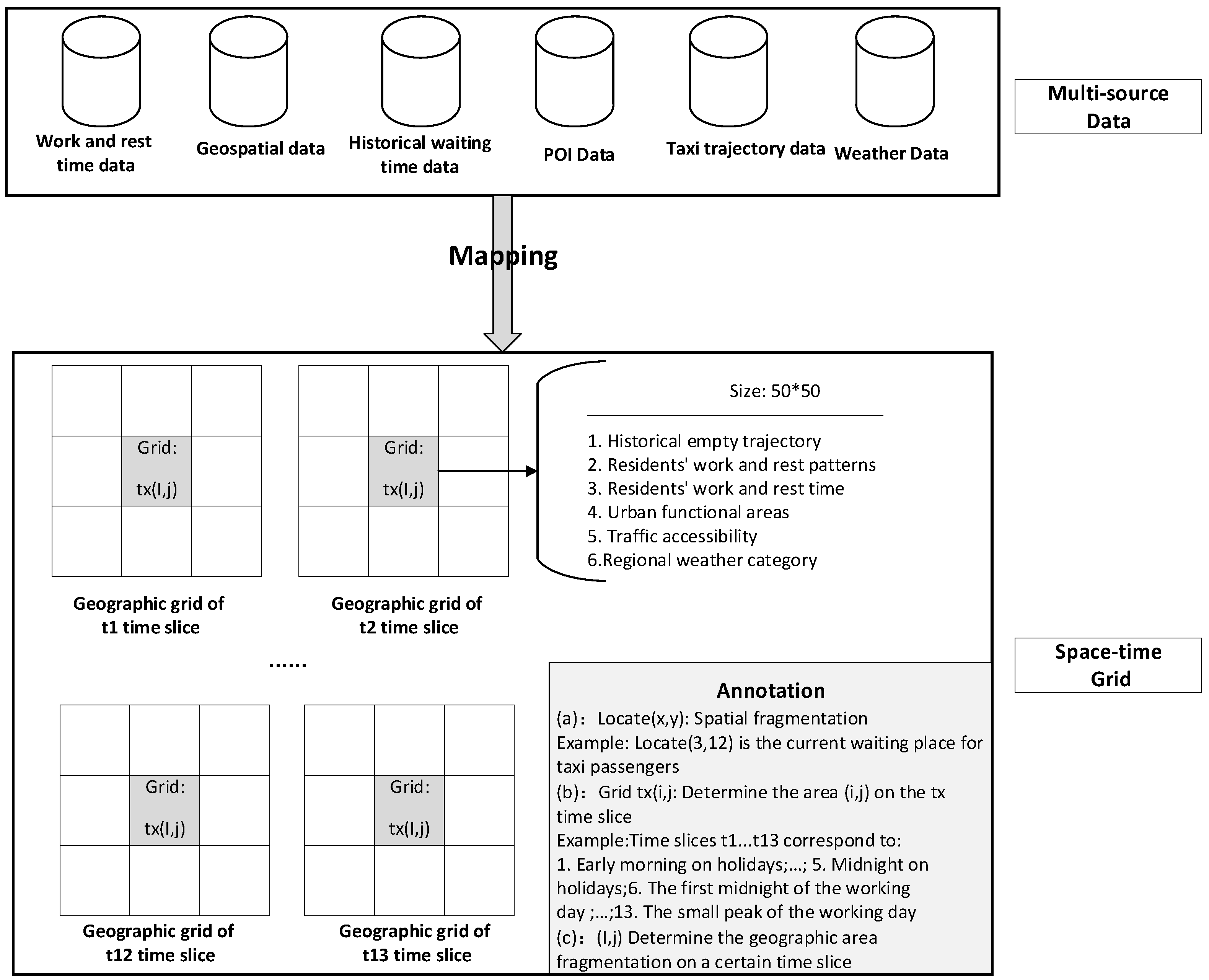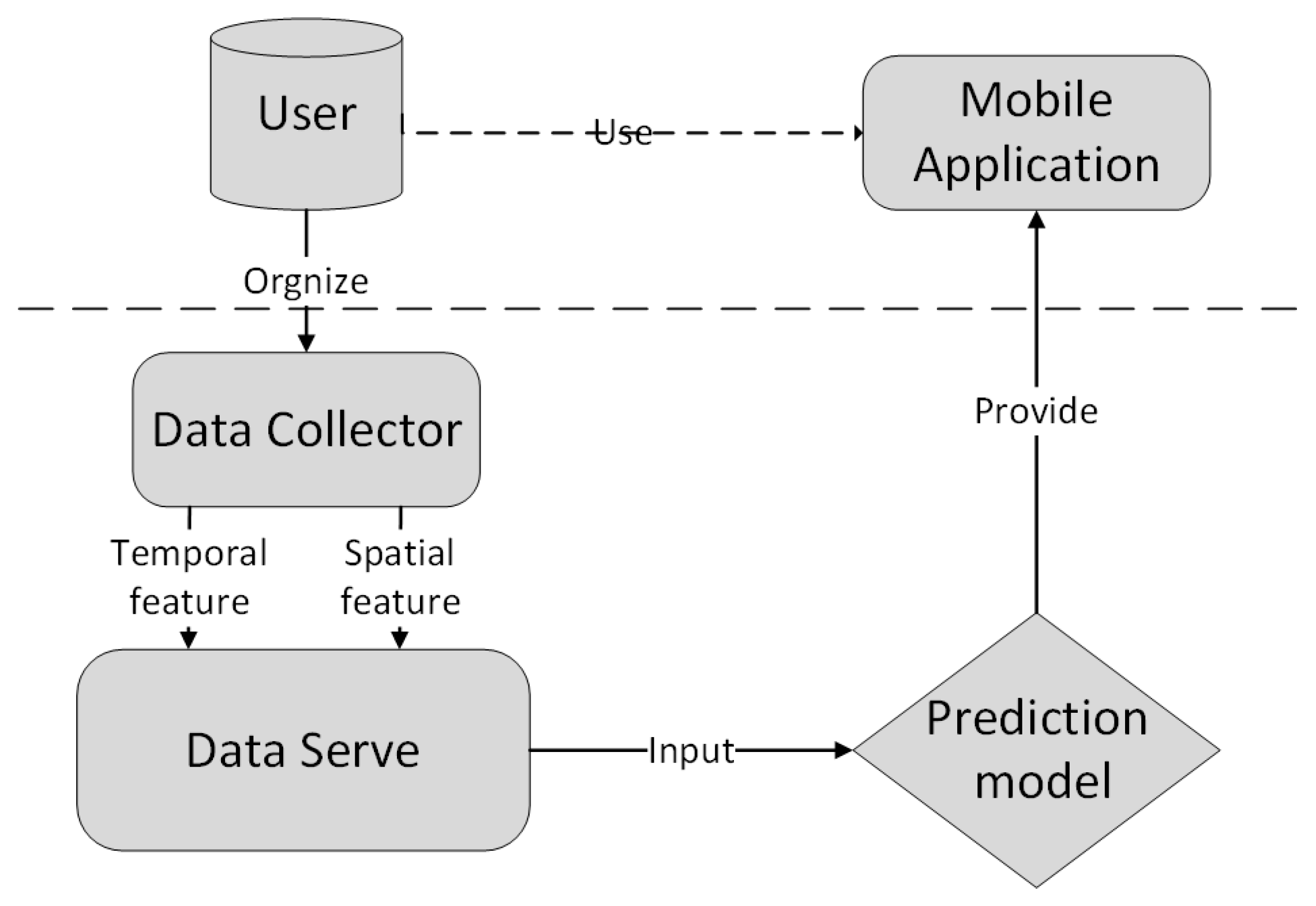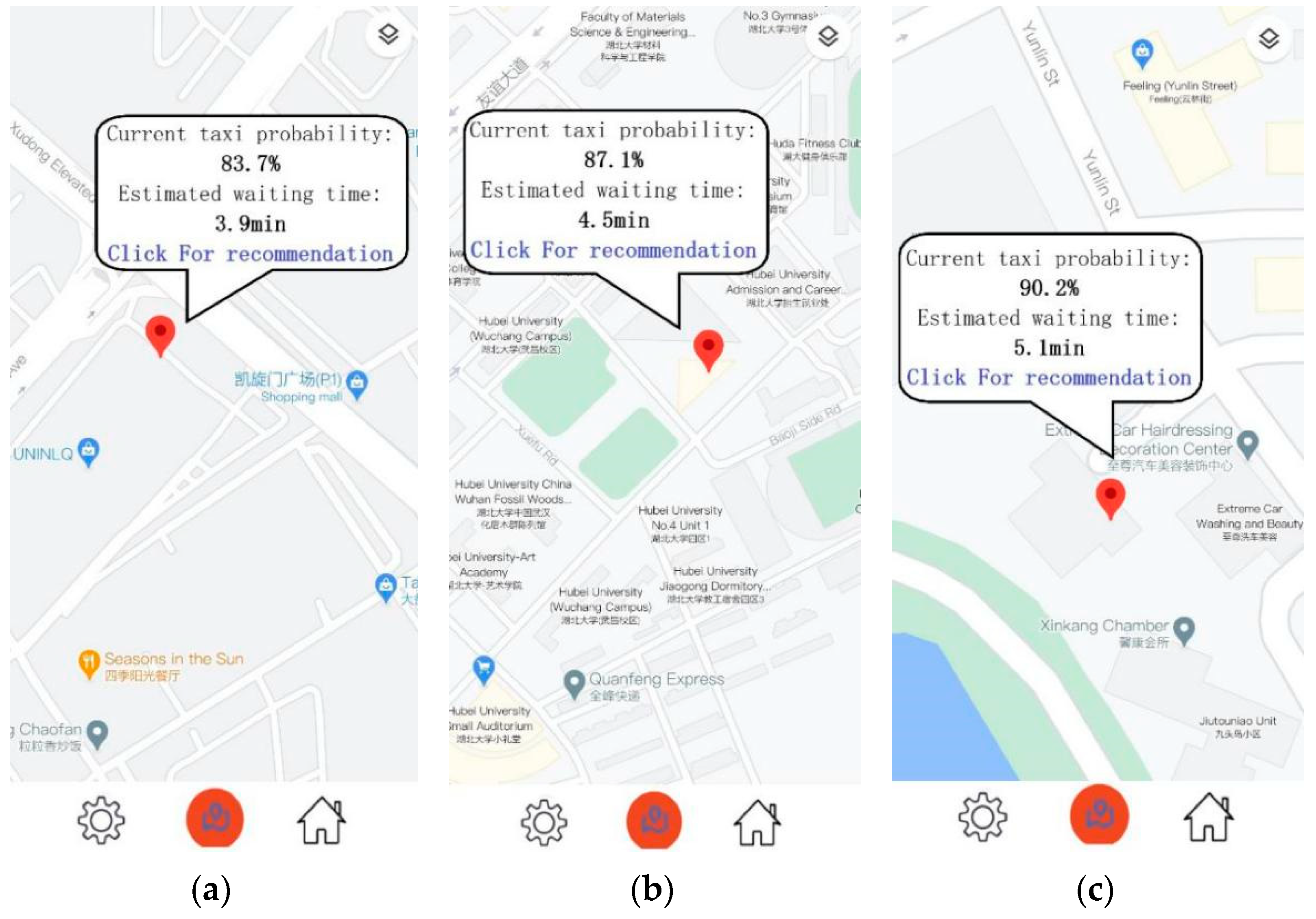1. Introduction
Over the past few years, with the rapid development of smart cities that provide many high-tech opportunities and novel services to human beings and decision-makers, transportation systems have also gradually evolved toward the concept of “smart travel”. Smart cities have the potential to offer novel interactive applications for either optimizing routes at the local level or transportation planning schemas at the city level [
1]. As one of the major means of transportation in the city, taxis have the advantage of flexibility and convenience, and can often meet residents’ travel demands [
2]. However, there is often an imbalance between taxi supplies and demands, this leading in many cases to long waiting times and thus an urgent need for reasonable and effective automated solutions [
3]. With the aim of bridging the gap between taxi demands and supplies with smart travels, this research introduces a neural network approach whose objective is to predict passengers’ taxi waiting times and provide passengers with optimized waiting places. Our approach is based on a combination of an optimized neural network, a grid-based spatio-temporal and functional structure of urban space and integration of multi-source data. Spatio-temporal and semantic data give the input of our modelling approach, from a selection of urban points of interest, historical taxi trajectory data including waiting times at specific locations and weather data. The whole approach is experimented in the Wuchang District of Wuhan in China using a set of real taxi trajectories recorded over a significant enough period of time and illustrated by a case study application that shows the interest of the whole modelling approach.
The rest of the paper is organized as follows. The next section provides a study of related work.
Section 3 introduces the principles behind our behavioral model and develops the neural network modelling approach.
Section 4 reports on the experimental results, while
Section 5 draws the conclusions and suggests a few perspectives for further work.
2. Related Work
Nowadays, most urban taxis have GPS positioning systems make massive taxi trajectory data easily available. Massive taxi trajectory data contains valuable data on urban transportation patterns as well as driving behaviors, and then useful references for studying urban residents’ activities and giving a global picture of an urban transportation system. This led to the concept of “urban computing” that offers new computerized models of the city and further opportunities for mining and discovering urban trajectory patterns [
4]. Indeed, before the emergence of smart cities, modelling and simulating urban taxi behaviors was, for instance, modelled using online algorithms and linear programming, taking into account taxi availabilities, pricing, number of passengers and waiting times [
5]. Passenger flows between large urban areas were modelled using a demand–supply equilibrium of taxi services under competition and regulation and minimizing passenger waiting times [
6].
With the development of IoT data, data-driven smart city computing has become an alternative promising resource for urban traffic flow analysis [
7,
8]. Incremental approaches based on historical taxi trajectory data can be applied to approximate both taxi demands and allocations to passengers [
9]. Neural networks are also used to predict the demand for taxis to serve the drivers. In order to predict the demand of taxis to help drivers plan their routes, the CNN-BiLSTM attention neural network has been introduced to predict taxis demand [
10]. Overall, it was shown that urban spatial-temporal flow prediction is of great importance to traffic management, land use, public safety, etc. Urban flows are affected by several complex and dynamic factors, such as patterns of human activities, weathers, events and holidays [
11]. Modeling this type of data can be enhanced by deep learning approaches [
12]. An attention-based convolutional recursive network was applied to predict taxi demands and correlate times and places [
13].
Unlike demand forecasting, neural networks were hardly applied with multi-source data to forecast passengers’ waiting time. Nowadays, the most widely used method is to repair and analyze a taxi path based on GPS trajectory to predict taxi waiting times. For instance, a bus route map can be constructed and segmented, based on real-time bus GPS data to derive a path-based waiting time prediction [
14]. A similar idea is used by applying three models to predict upstream bus routes separately to provide short-term forecasts for public transportation [
15]. Large GPS trajectory data are empirically processed to derive taxi waiting time probabilities at some given locations and times [
16]. Similarly, routing protocols and path-finding models are used as references for also deriving taxi waiting times at some given locations [
17]. Elsewhere, the XGBoost algorithm is applied to predict static waiting times of taxis [
18]. A crossroad network-based Markov decision process scheme is suggested to recommend taxi waiting place [
19]. Recently, the importance of spatio-temporal features in traffic flow predictions is receiving more and more attention. The spatio-temporal features of the trajectory images are used in the prediction while the influence of space and weather are ignored [
20]. GPS data is used to discover the impact of weather on human flow patterns [
21]. The spatio-temporal semantics of the area are inferred to improve the accuracy [
22]. Considering that a certain sequence may exist when people pass through the different geographic regions, time and space factors are utilized in learning the sequence rules of vehicles passing through different geographic functional regions [
22].
Overall, while there has been valuable progress in the way historical taxi trajectory data are combined with city traffic flow calculation, it appears that the accuracy of urban taxi waiting time prediction models still needs to be further improved. In particular, many factors are not taken into account, from taxi driving rules to passenger behavior in the city according to different timelines [
23]. Furthermore, urban taxi drivers are rarely affected by dispatch centers, especially in China. In recent years, car-hailing apps appear as valuable solutions through which a passenger can directly order a taxi online. Taxi dispatching algorithm used in car-hailing apps have a great impact on the taxi running rules, which effectively reduced waiting times to a certain extent. The mode of demand–response (DR) taxi, such as Didi in China, UBER in the USA is able to show the waiting times for users, while this is the possible waiting time taken to drive from the location of the taxi whose driver is willing to go to the user’s place. The length of this waiting time in DR mode is decided by the distance between the responding taxi and user. Users always prefer to know the possible arrival time of the 1st empty taxi that is based on historic experiences. Learning taxi running rules from a large amount of historic taxi trajectory is a promising method for the waiting time prediction. This paper introduces a spatio-temporal schedule-based neural network model for urban taxi waiting time prediction. Based on the implicit influence of time, location, weather and urban residents’ daily schedules, the neural network was designed to learn taxi running rules for deriving the most accurate prediction of taxi waiting times.
5. Conclusions and Future Work
Over the past few years, the emergence of many sensor-based applications in urban environments progressively favors the emergence of the concept of smart cities. Among a wide range of novel services offered to urban residents and decision-makers, transportation on demand has radically changed the way operations are distributed amongst potential passengers and delivery companies. When considering and modelling taxi demand and supplies, many factors impact the waiting times of taxi passengers, from the efficiency of the urban network infrastructure to the functional organization of the city, to the optimization of taxi resources and passenger pickup locations, to traffic flows to mention a few examples [
40].
The research developed in this paper introduced an experimental neural network model whose objective is to predict and optimize taxi allocation times to passenger demands in an urban environment. The approach is based on a close integration of multi-dimensional data, from historical taxi trajectories, to a spatio-temporal distribution of human behaviors in the city according to different functional, temporal constraints and weathers. The applicability, accuracy and effectiveness of the proposed model are primarily compared with actual historical taxi trajectory data and a spatio-temporal behavioral model of urban residents. Lastly, the whole neural network approach is compared to a few alternative modelling approaches. We conducted experiments with 70 days of taxi trajectory data in Wuhan. The experimental results show that under the weather at any time and place, the MAE value of the prediction result of this model is less than 73.27, and the RSME value is less than 7.33. The results also show that our modelling approach performs relatively well in terms of accuracy and efficiency.
The advantage of this modelling approach is twofold: it can help taxi drivers to reduce the no-load rate while reducing waste of energy resources, and it can improve the balance between the supply and demand of taxis and passengers to some extent this being a key issue in taxi demand allocation tasks [
40]. For passengers, predicting the waiting time in advance can also improve the success rate of taking a taxi and help passengers arrange their journey appropriately.
Although the research has made some preliminary progress, additional issues need to be further developed. Subsequent work will continue around the following three points: first by further optimizing the time–space modeling, such as different holidays and area without function category identification. Secondly, based on predicted taxi waiting times, the optimization of allocation pickup points might be still explored with further algorithmic approaches. Third, the generalization performance will be in consideration.




















